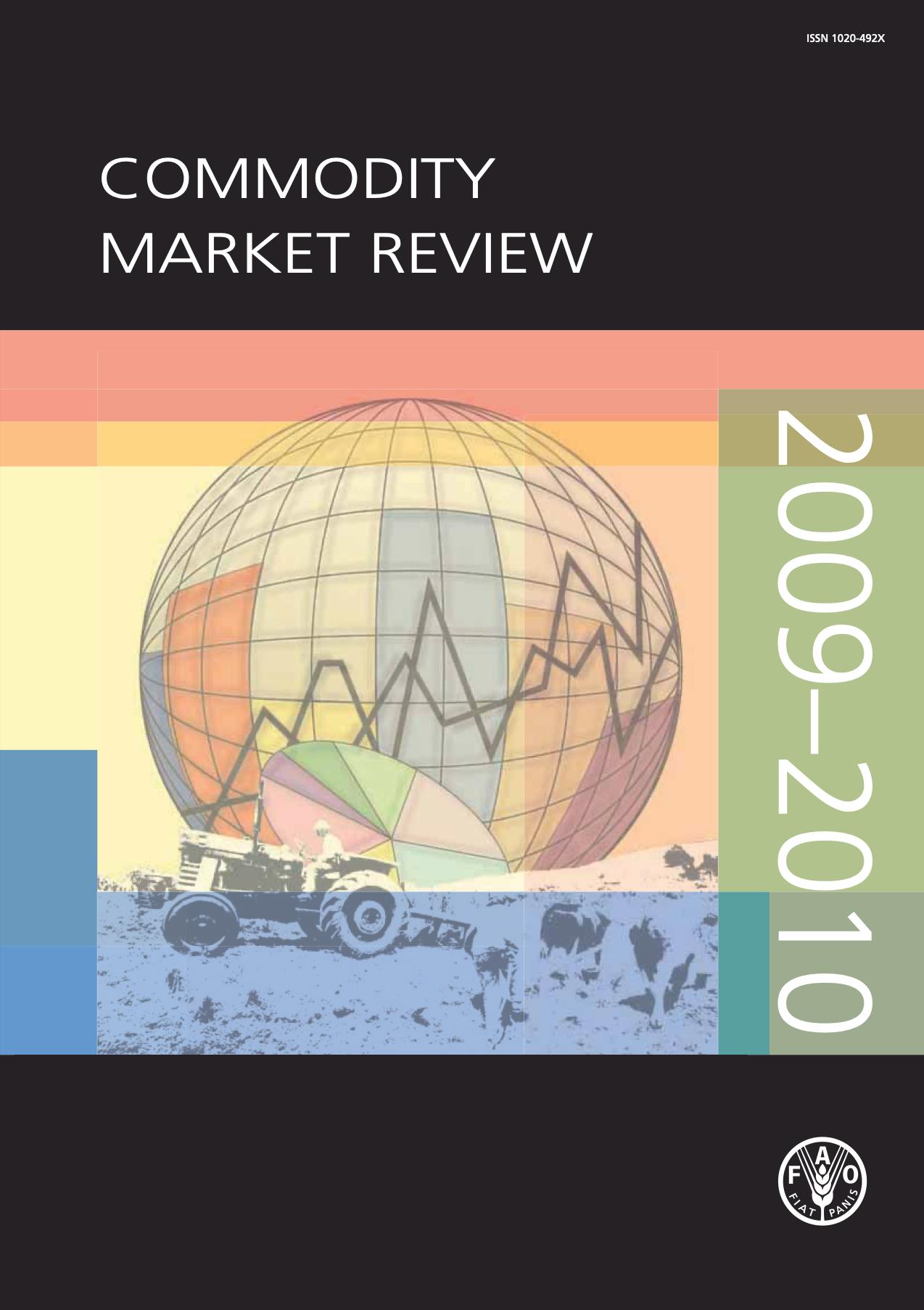
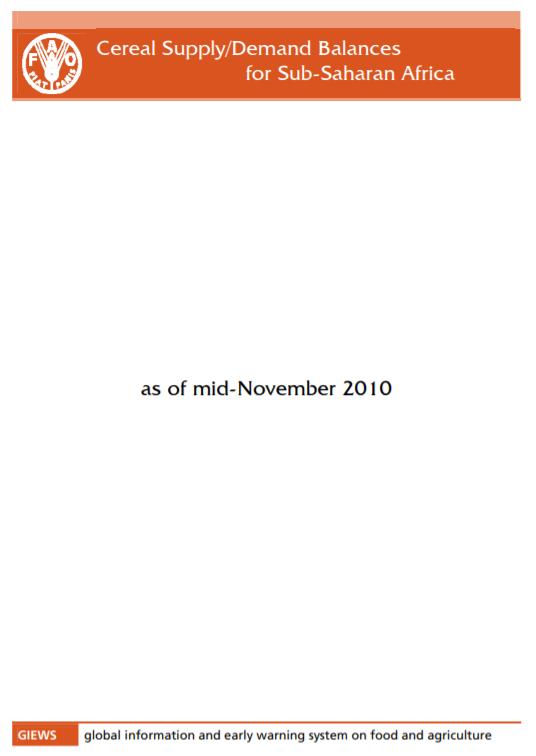
Cereal supply and demand balances for sub-Saharan African countries - No.4, November 2010
18/11/2010
The FAO/GIEWS Country Cereal Balance System (CCBS) is a database of annual supply and utilization balances for main cereals, covering all countries of the world. It has been maintained by FAO/GIEWS since 1980 and is updated on a continual basis. This statistical report, which is a subset of CCBS data, presents the current-year cereal supply and demand balances for all sub-Saharan African countries, highlighting cereal import and food aid requirements of each country. This report is complement ary to the FAO/GIEWS report Crop Prospects and Food Situation and is published four times a year, with the same schedule.
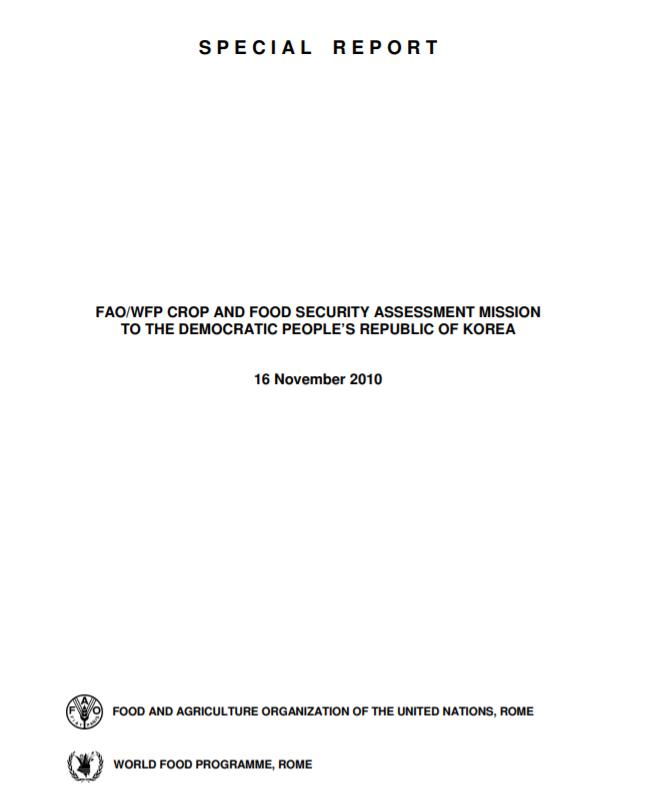
Special Report - FAO/WFP Crop and Food Security Assessment Mission to the Democratic People's Republic of Korea - 16 November 2010
16/11/2010
An FAO/WFP Crop and Food Security Assessment Mission (CFSAM) visited DPRK at the request of the Government from 21 September to 2 October to assess the 2010 main-crop harvest, to forecast the 2011 production of winter and spring crops, and to estimate cereal import requirements for the 2010/11 marketing year (November/October), including food assistance needs.
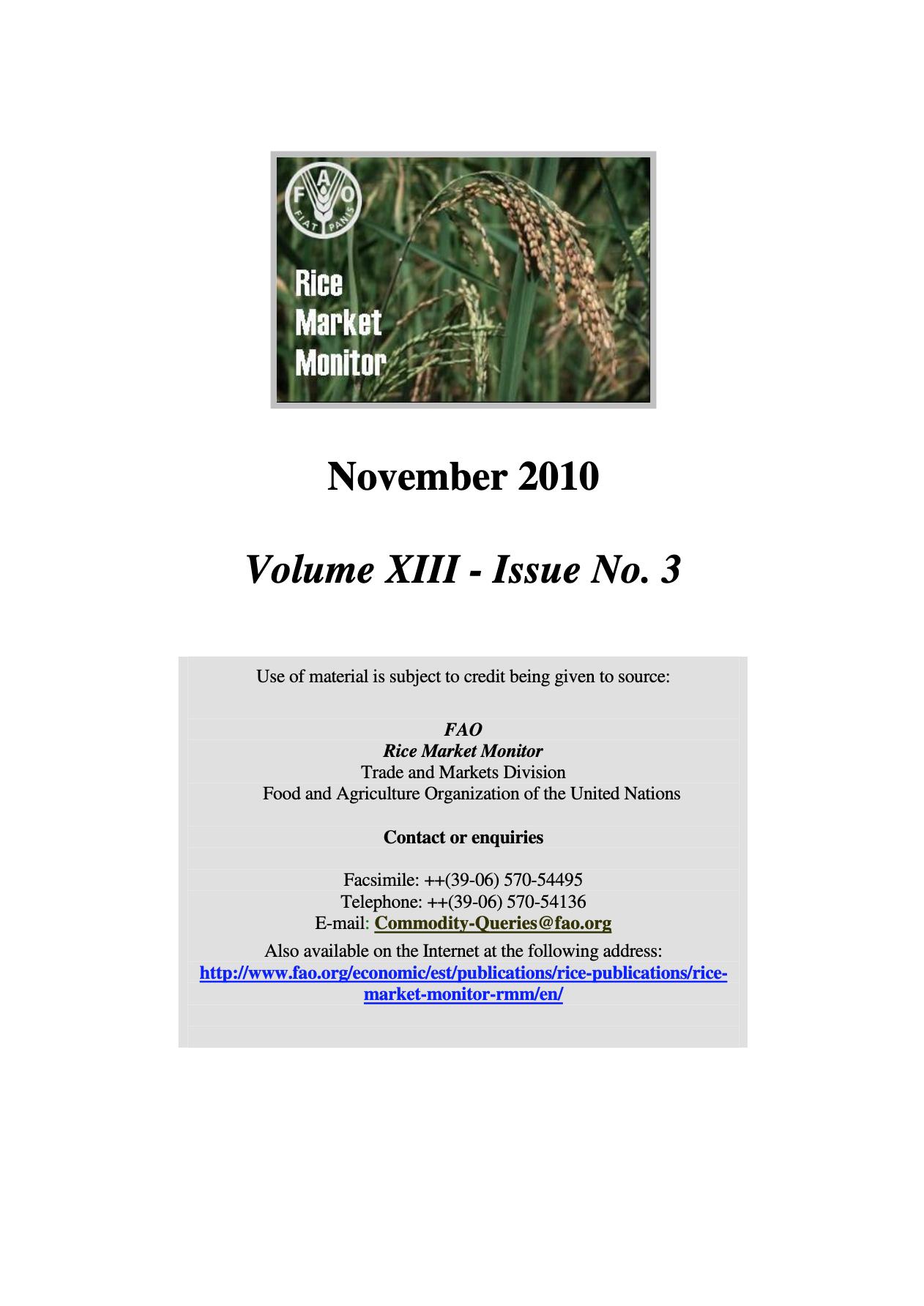
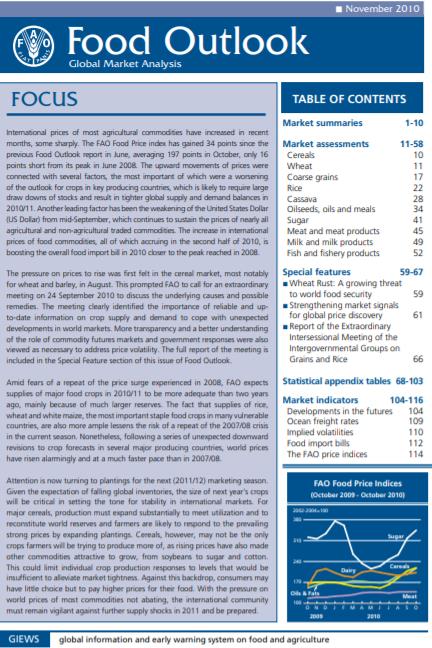
Food Outlook - November 2010
03/11/2010
International prices of most agricultural commodities have increased in recent months, some sharply. The FAO Food Price index has gained 34 points since the previous Food Outlook report in June, averaging 197 points in October, only 16 points short from its peak in June 2008. The upward movements of prices were connected with several factors, the most important of which were a worsening of the outlook for crops in key producing countries, which is likely to require large draw downs of stocks and result in tighter global supply and demand balances in 2010/11. Another leading factor has been the weakening of the United States Dollar (US Dollar) from mid-September, which continues to sustain the prices of nearly all agricultural and non-agricultural traded commodities. The increase in international prices of food commodities, all of which accruing in the second half of 2010, is boosting the overall food import bill in 2010 closer to the peak reached in 2008.
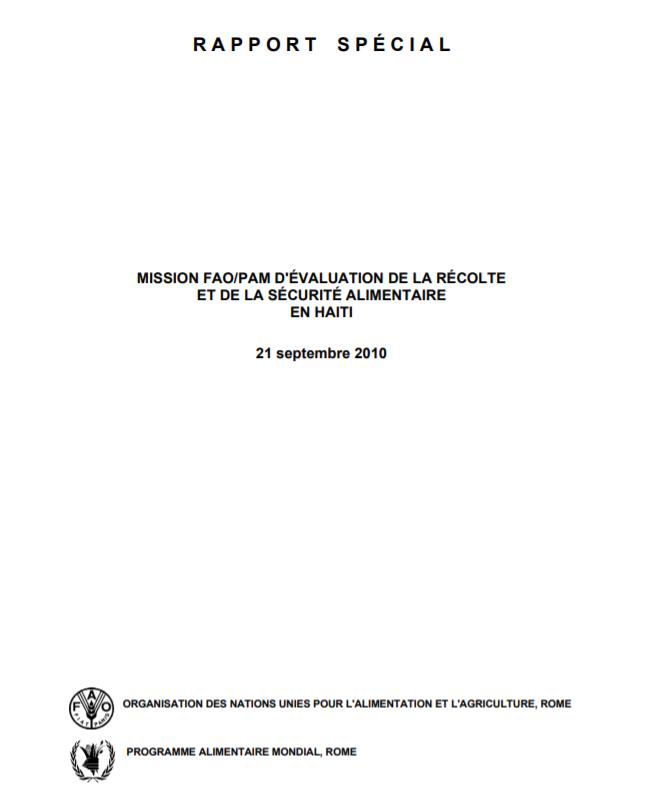
Rapport Spécial - Mission FAO/PAM D'Évaluation de la Récolte et de la Sécurité Alimentaire en Haiti
21/09/2010
Une Mission FAO/PAM d’évaluation des récoltes et de la sécurité alimentaire a séjourné en Haïti du 16 juin au 13 juillet 2010 pour estimer la production vivrière de la saison de printemps 2010 et les prochaines récoltes des saisons d’été et d’automne/hiver ainsi que les besoins d’importations céréalières pour l’année commerciale 2010/11. Les techniciens du Ministère de l’agriculture, des ressources naturelles et du développement rural (MARNDR) ont prêté leur concours à la Mission dans la capitale Port-au-Prince et sur le terrain. En particulier, les responsables de l’unité d’Étude et de programmation et du service statistique du MARNDR ainsi que la Coordination nationale de la sécurité alimentaire (CNSA) avec leur structure d’Observatoires, ont participé activement aux tâches administratives et aux activités sur le terrain et ont fourni des renseignements détaillés sur la situation alimentaire actuelle et à venir.
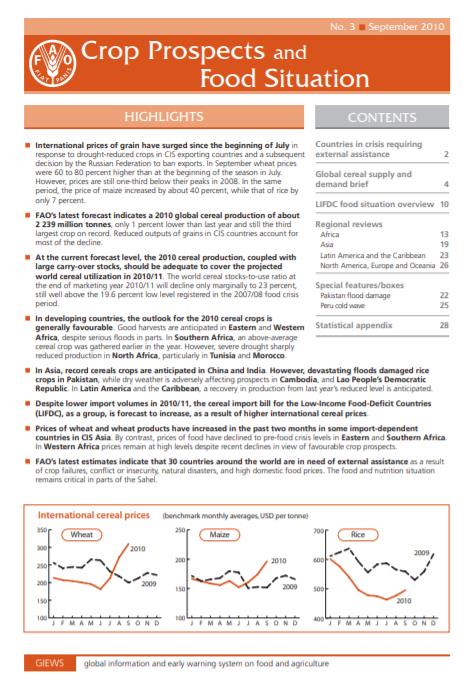
Crop Prospects and Food Situation #3, September 2010
09/09/2010
International prices of grain have surged since the beginning of July in response to drought-reduced crops in CIS exporting countries and a subsequent decision by the Russian Federation to ban exports. In September wheat prices were 60 to 80 percent higher than at the beginning of the season in July. However, prices are still one-third below their peaks in 2008. In the same period, the price of maize increased by about 40 percent, while that of rice by only 7 percent. FAO’s latest forecast indicates a 2010 global cereal production of about 2 239 million tonnes, only 1 percent lower than last year and still the third largest crop on record. Reduced outputs of grains in CIS countries account for most of the decline. At the current forecast level, the 2010 cereal production, coupled with large carryover stocks, should be adequate to cover the projected world cereal utilization in 2010/11. The world cereal stocks-to-use ratio at the end of marketing year 2010/11 will decline only marginally to 23 percent, still well above the 19.6 percent low level registered in the 2007/08 food crisis period.
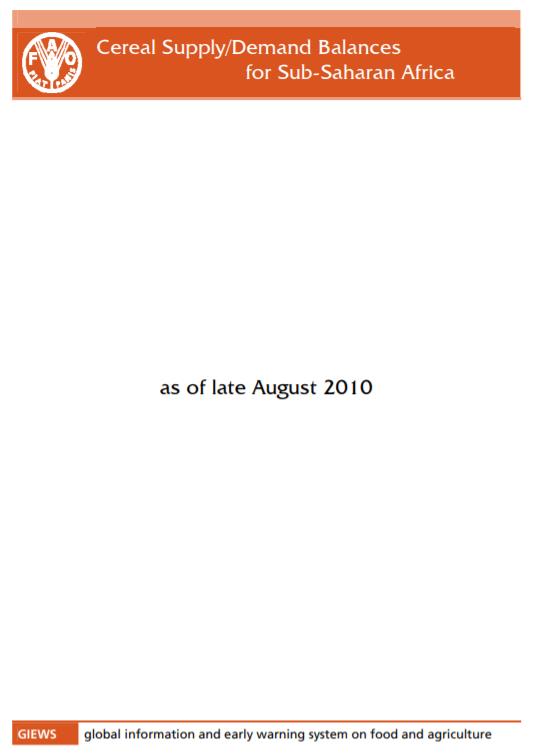
Cereal supply and demand balances for sub-Saharan African countries - No.3, August 2010
31/08/2010
The FAO/GIEWS Country Cereal Balance System (CCBS) is a database of annual supply and utilization balances for main cereals, covering all countries of the world. It has been maintained by FAO/GIEWS since 1980 and is updated on a continual basis. This statistical report, which is a subset of CCBS data, presents the current-year cereal supply and demand balances for all sub-Saharan African countries, highlighting cereal import and food aid requirements of each country. This report is complement ary to the FAO/GIEWS report Crop Prospects and Food Situation and is published four times a year, with the same schedule.
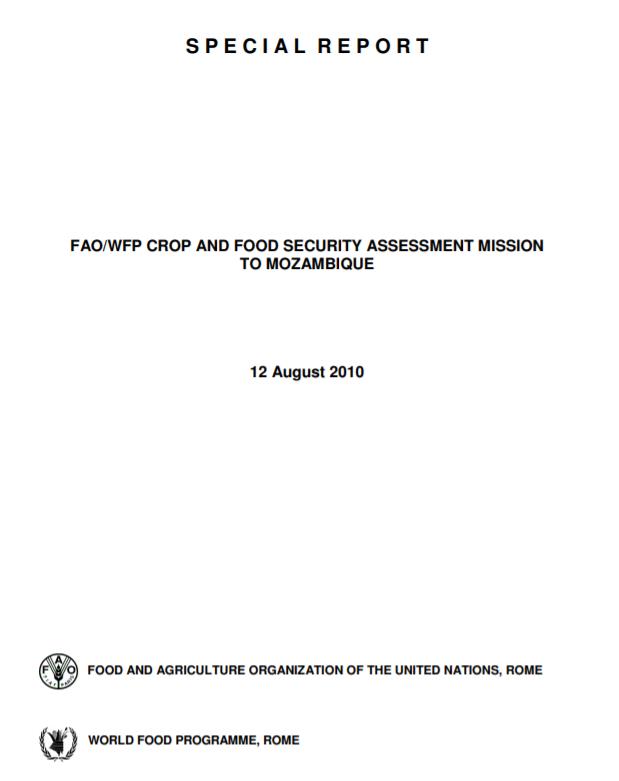
Special Report - FAO/WFP Crop and Food Security Assessment Mission to Mozambique - 12 August 2010
12/08/2010
Following reports of poor harvest expectations in central and southern provinces due to a prolonged dry spell, an FAO/WFP Crop and Food Security Assessment Mission (CFSAM) visited the country from 6 to 29 May 2010. The Mission evaluated food crop production in the 2009/10 agricultural season, assessed the overall food supply situation, forecast cereal import requirements and possible exports in marketing year 2010/11 (April/March) and determined the eventual food aid needs.

Special Report - FAO/WFP Crop and Food Security Assessment Mission to Zimbabwe - 9 August 2010
09/08/2010
Following a period of unfavourable rainfall distribution in December and January, particularly in the eastern and central parts of country, the Government of Zimbabwe requested a FAO and WFP independent evaluation. In response, a joint FAO/WFP Crop and Food Security Assessment Mission (CFSAM) visited the country between 14-18 June 2010, to conduct a condensed assessment of the 2009/10 cereal production and evaluate the overall food security situation to determine the food import requirement, including food assistance needs, for the current marketing year 2010/11 (April/March). In consideration of the technical support FAO and WFP provided to the Government for the First and the Second Round Crop and Livestock Assessments and the timing of the Mission, it was decided that a condensed CFSAM would be most appropriate.

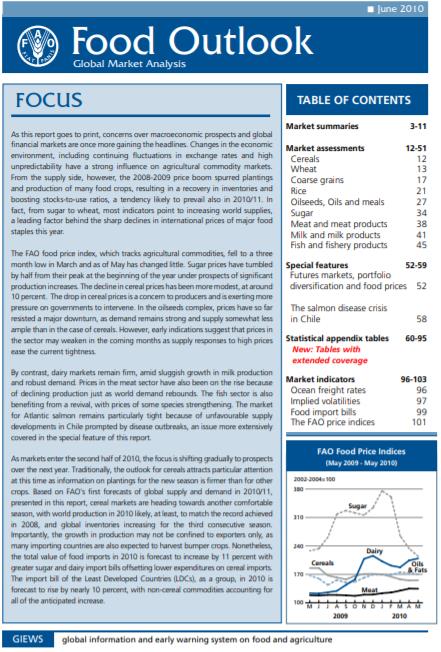
Food Outlook - June 2010
03/06/2010
As this report goes to print, concerns over macroeconomic prospects and global financial markets are once more gaining the headlines. Changes in the economic environment, including continuing fluctuations in exchange rates and high unpredictability have a strong influence on agricultural commodity markets. From the supply side, however, the 2008-2009 price boom spurred plantings and production of many food crops, resulting in a recovery in inventories and boosting stocks-to-use ratios, a tendency likely to prevail also in 2010/11. In fact, from sugar to wheat, most indicators point to increasing world supplies, a leading factor behind the sharp declines in international prices of major food staples this year.
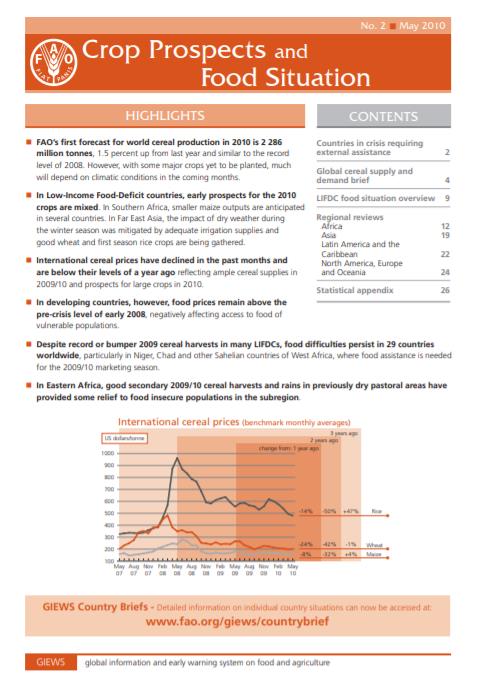
Crop Prospects and Food Situation #2, May 2010
06/05/2010
FAO’s first forecast for world cereal production in 2010 is 2 286 million tonnes, 1.5 percent up from last year and similar to the record level of 2008. However, with some major crops yet to be planted, much will depend on climatic conditions in the coming months. In Low-Income Food-Deficit countries, early prospects for the 2010 crops are mixed. In Southern Africa, smaller maize outputs are anticipated in several countries. In Far East Asia, the impact of dry weather during the winter season was mitigated by adequate irrigation supplies and good wheat and first season rice crops are being gathered. International cereal prices have declined in the past months and are below their levels of a year ago reflecting ample cereal supplies in 2009/10 and prospects for large crops in 2010.
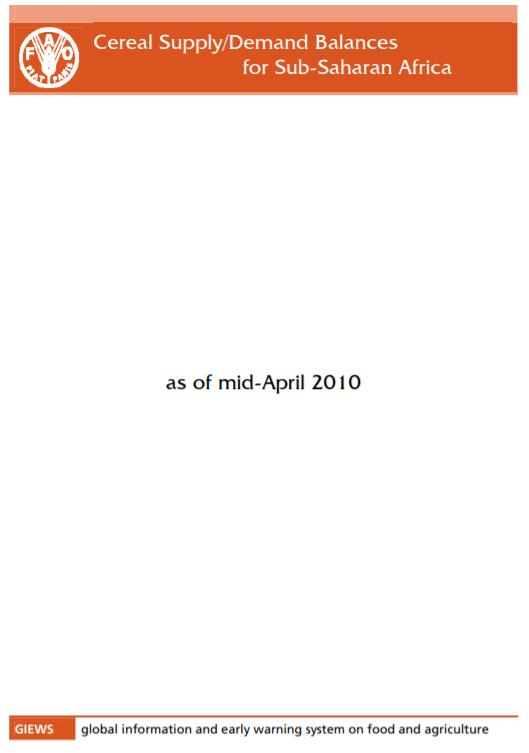
Cereal supply and demand balances for sub-Saharan African countries - No.2, April 2010
22/04/2010
The FAO/GIEWS Country Cereal Balance System (CCBS) is a database of annual supply and utilization balances for main cereals, covering all countries of the world. It has been maintained by FAO/GIEWS since 1980 and is updated on a continual basis. This statistical report, which is a subset of CCBS data, presents the current-year cereal supply and demand balances for all sub-Saharan African countries, highlighting cereal import and food aid requirements of each country. This report is complement ary to the FAO/GIEWS report Crop Prospects and Food Situation and is published four times a year, with the same schedule.
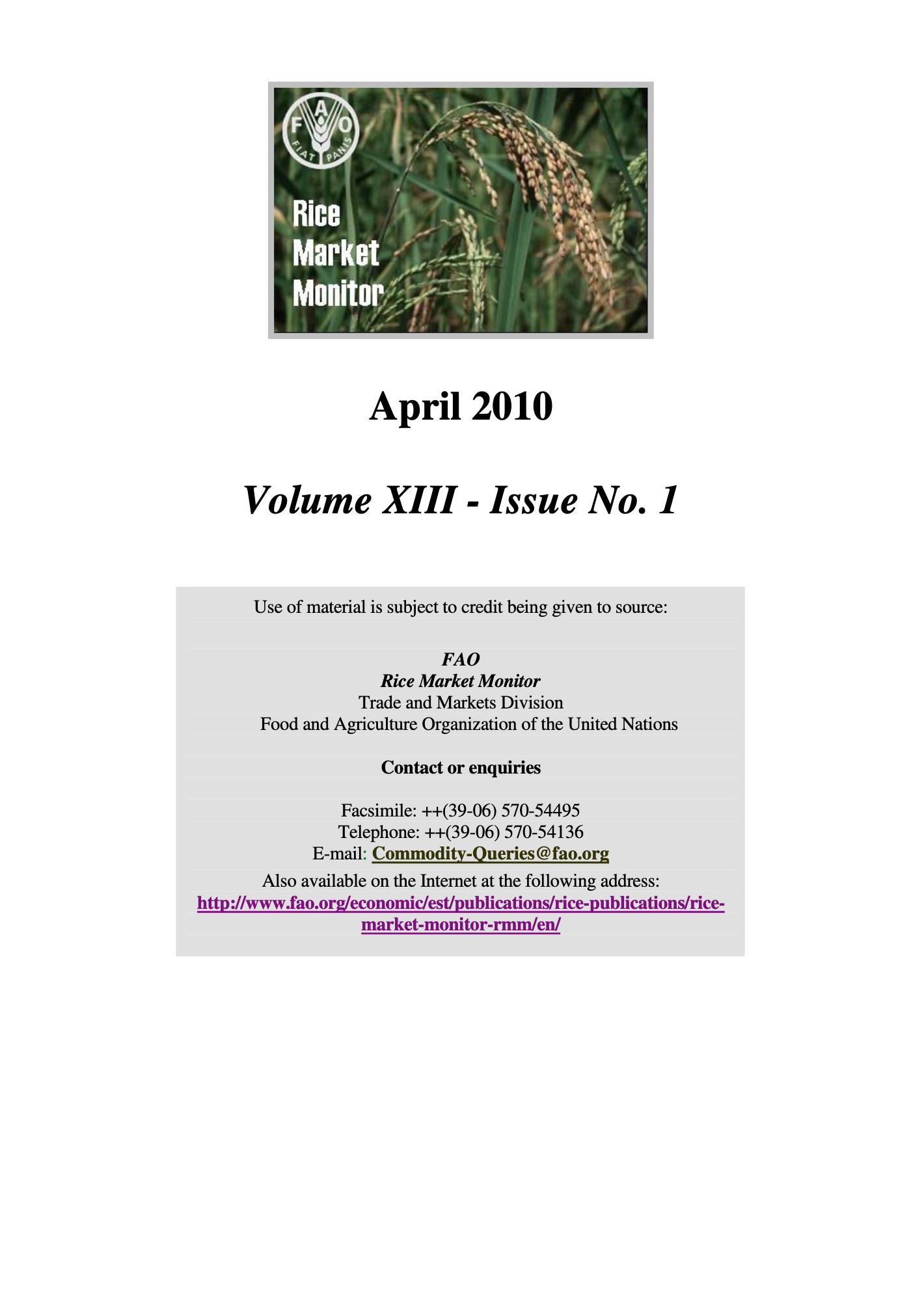
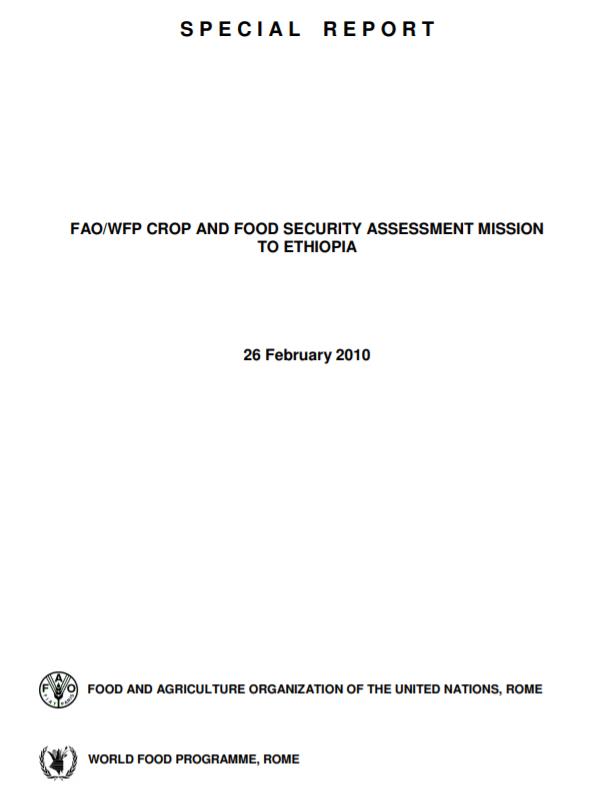
Special Report - FAO/WFP Crop and Food Security Assessment Mission to Ethiopia - 26 February 2010
26/02/2010
An FAO/WFP Crop and Food Security Assessment Mission visited Ethiopia from 9 November to 4 December 2009 to estimate the 2009 main meher season cereal and pulse production; review the 2009 secondary belg season harvests; forecast the 2010 belg season production; and assess the overall food supply situation for the 2010 marketing year (January/December). Accompanied by experts from the Ministry of Agriculture and Rural Development (MoARD), the Central Statistics Authority (CSA) and by observers from USAID/FEWSNet and the Joint Research Centre of the European Commission (EC-JRC), the Mission mobilized seven teams and visited, over an 18-day period, 62 zones and special woredas (districts) covering all the grain producing regions and the marginal areas.
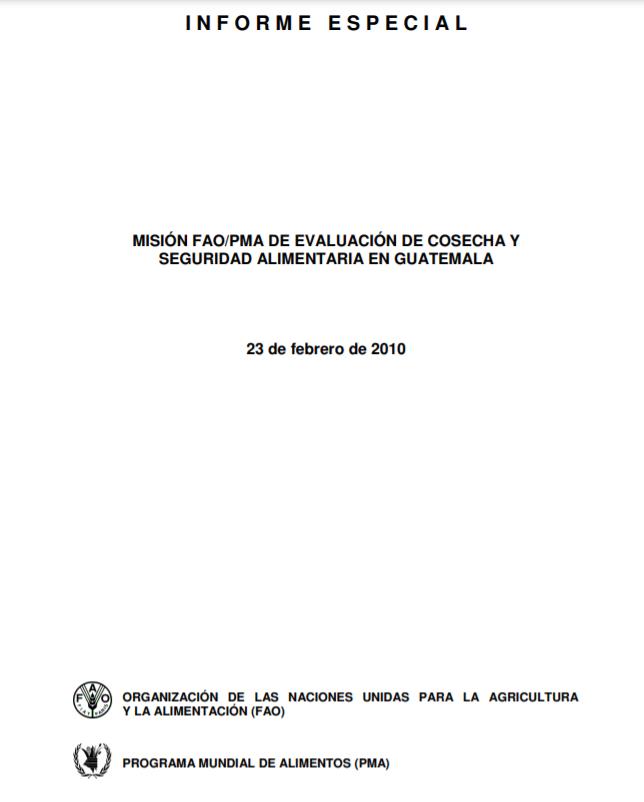
Informe Especial - Misión FAO/PMA de Evaluación de Cosecha y Seguridad Alimentaria en Guatemala
23/02/2010
La Misión conjunta FAO/PMA de Evaluación de Cosecha y Seguridad Alimentaría (CFSAM) visitó Guatemala desde el 3 hasta el 23 de noviembre de 2009. La Misión tuvo como objetivo la evaluación de la producción de los granos básicos (maíz, fríjol y arroz), localmente afectados por eventos climáticos adversos en las áreas denominadas del corredor seco sobre todo en la Región Oriente del país.
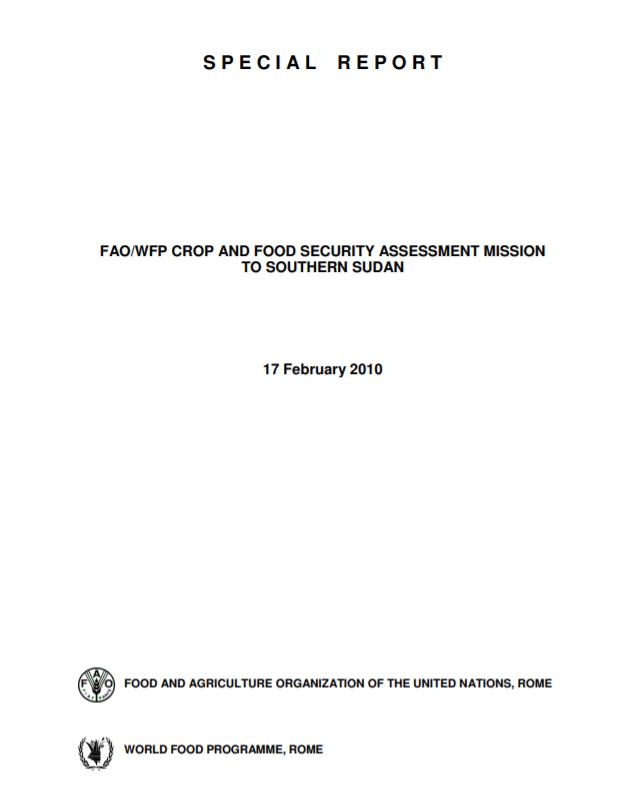
Special Report - FAO/WFP Crop and Food Security Assessment Mission to Southern Sudan - 17 February 2010
17/02/2010
An FAO/WFP Crop and Food Security Assessment Mission (CFSAM) visited Southern Sudan from 19 October to 14 November 2009 to estimate cereal production and assess the overall food-security situation. The Mission included representatives from the Government of Southern Sudan (GOSS), the Ministry of Agriculture and Forestry (MoAF), the Southern Sudan Relief and Rehabilitation Commission (SSRRC), FEWSNet, FAO and WFP.
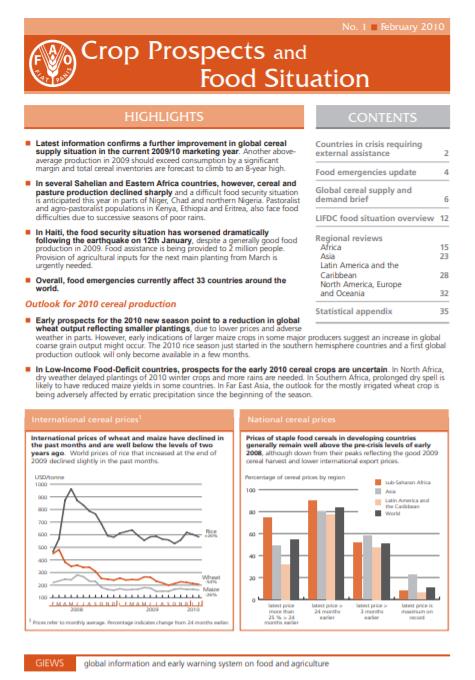
Crop Prospects and Food Situation #1, February 2010
11/02/2010
Latest information confirms a further improvement in global cereal supply situation in the current 2009/10 marketing year. Another aboveaverage production in 2009 should exceed consumption by a significant margin and total cereal inventories are forecast to climb to an 8-year high. In several Sahelian and Eastern Africa countries, however, cereal and pasture production declined sharply and a difficult food security situation is anticipated this year in parts of Niger, Chad and northern Nigeria. Pastoralist and agro-pastoralist populations in Kenya, Ethiopia and Eritrea, also face food difficulties due to successive seasons of poor rains. In Haiti, the food security situation has worsened dramatically following the earthquake on 12th January, despite a generally good food production in 2009. Food assistance is being provided to 2 million people. Provision of agricultural inputs for the next main planting from March is urgently needed. Overall, food emergencies currently affect 33 countries around the world.
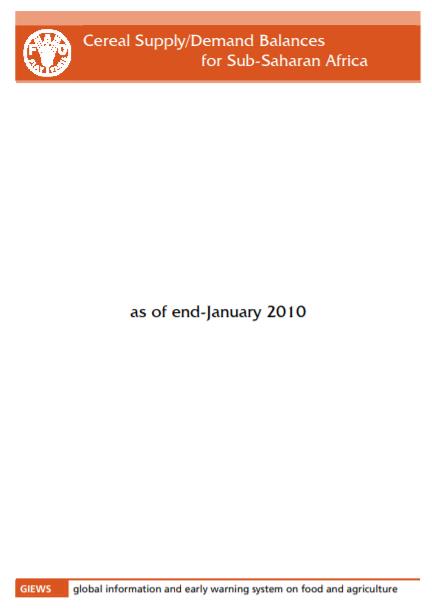
Cereal supply and demand balances for sub-Saharan African countries - No.1, January 2010
29/01/2010
The FAO/GIEWS Country Cereal Balance System (CCBS) is a database of annual supply and utilization balances for main cereals, covering all countries of the world. It has been maintained by FAO/GIEWS since 1980 and is updated on a continual basis. This statistical report, which is a subset of CCBS data, presents the current-year cereal supply and demand balances for all sub-Saharan African countries, highlighting cereal import and food aid requirements of each country. This report is complement ary to the FAO/GIEWS report Crop Prospects and Food Situation and is published four times a year, with the same schedule.
